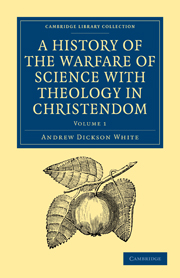Book contents
- Frontmatter
- INTRODUCTION
- Contents
- CHAPTER I FROM CREATION TO EVOLUTION
- CHAPTER II GEOGRAPHY
- CHAPTER III ASTRONOMY
- CHAPTER IV FROM “SIGNS AND WONDERS” TO LAW IN THE HEAVENS
- CHAPTER V FROM GENESIS TO GEOLOGY
- CHAPTER VI THE ANTIQUITY OF MAN, EGYPTOLOGY, AND ASSYRIOLOGY
- CHAPTER VII THE ANTIQUITY OF MAN AND PREHISTORIC ARCHÆOLOGY
- CHAPTER VIII THE “FALL OF MAN” AND ANTHROPOLOGY
- CHAPTER IX THE “FALL OF MAN” AND ETHNOLOGY
- CHAPTER X THE “FALL OF MAN” AND HISTORY
- CHAPTER XI FROM “THE PRINCE OF THE POWER OF THE AIR” TO METEOROLOGY
- CHAPTER XII FROM MAGIC TO CHEMISTRY AND PHYSICS
CHAPTER I - FROM CREATION TO EVOLUTION
Published online by Cambridge University Press: 29 August 2010
- Frontmatter
- INTRODUCTION
- Contents
- CHAPTER I FROM CREATION TO EVOLUTION
- CHAPTER II GEOGRAPHY
- CHAPTER III ASTRONOMY
- CHAPTER IV FROM “SIGNS AND WONDERS” TO LAW IN THE HEAVENS
- CHAPTER V FROM GENESIS TO GEOLOGY
- CHAPTER VI THE ANTIQUITY OF MAN, EGYPTOLOGY, AND ASSYRIOLOGY
- CHAPTER VII THE ANTIQUITY OF MAN AND PREHISTORIC ARCHÆOLOGY
- CHAPTER VIII THE “FALL OF MAN” AND ANTHROPOLOGY
- CHAPTER IX THE “FALL OF MAN” AND ETHNOLOGY
- CHAPTER X THE “FALL OF MAN” AND HISTORY
- CHAPTER XI FROM “THE PRINCE OF THE POWER OF THE AIR” TO METEOROLOGY
- CHAPTER XII FROM MAGIC TO CHEMISTRY AND PHYSICS
Summary
THE VISIBLE UNIVERSE
Among those masses of cathedral sculpture which preserve so much of mediæval theology, one frequently recurring group is noteworthy for its presentment of a time-honoured doctrine regarding the origin of the universe.
The Almighty, in human form, sits benignly, making the sun, moon, and stars, and hanging them from the solid firmament which supports the “heaven above” and overarches the “earth beneath.”
The furrows of thought on the Creator's brow show that in this work he is obliged to contrive; the knotted muscles upon his arms show that he is obliged to toil; naturally, then, the sculptors and painters of the mediæval and early modern period frequently represented him as the writers whose conceptions they embodied had done—as, on the seventh day, weary after thought and toil, enjoying wellearned repose and the plaudits of the hosts of heaven.
In these thought-fossils of the cathedrals, and in other revelations of the same idea through sculpture, painting, glass-staining, mosaic work, and engraving, during the Middle Ages and the two centuries following, culminated a belief which had been developed through thousands of years, and which has determined the world's thought until our own time.
Its beginnings lie far back in human history; we find them among the early records of nearly all the great civilizations, and they hold a most prominent place in the various sacred books of the world.
- Type
- Chapter
- Information
- Publisher: Cambridge University PressPrint publication year: 2009First published in: 1896



